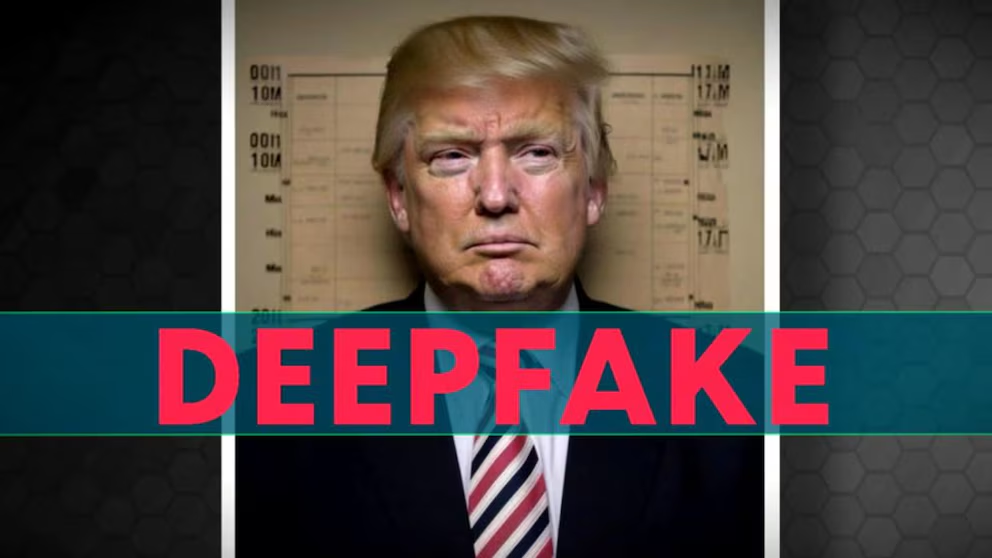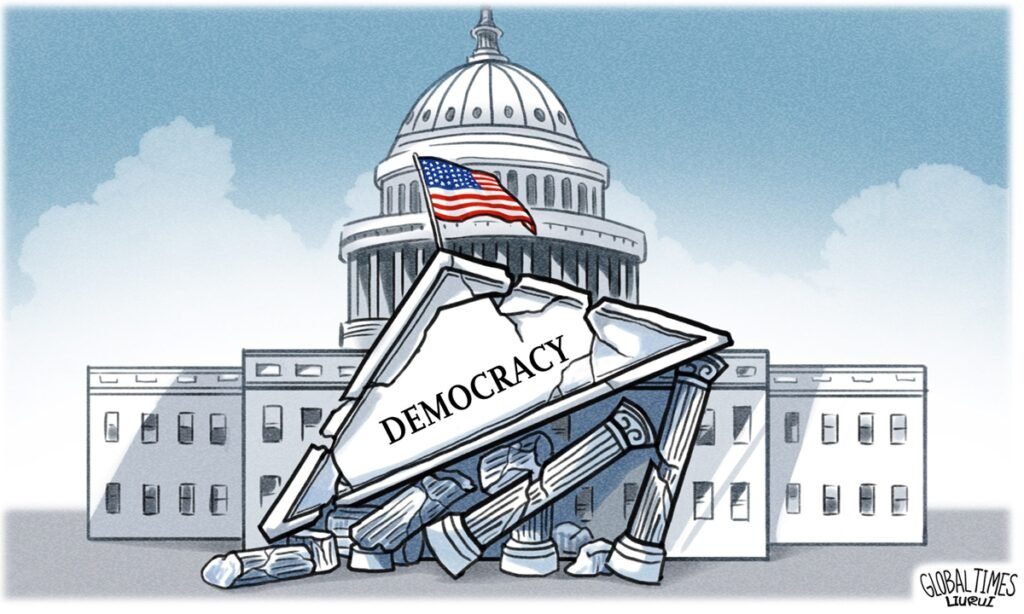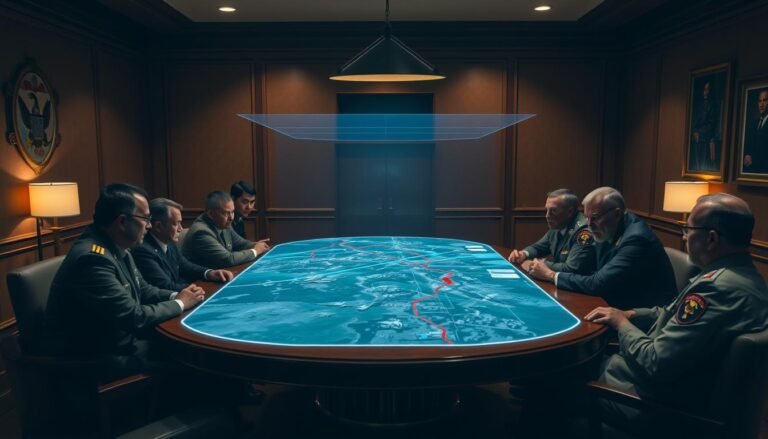Trump Deepfake: 5 Dangerous Threats to Democracy
In the turbulent theater of modern politics, we have become dangerously desensitized to a constant barrage of inflammatory rhetoric and digital mudslinging. Yet, even in this environment, certain actions retain the power to shock—not just for their content, but for the dark new territory they chart. On a seemingly ordinary Sunday, a line was crossed…

In the turbulent theater of modern politics, we have become dangerously desensitized to a constant barrage of inflammatory rhetoric and digital mudslinging. Yet, even in this environment, certain actions retain the power to shock—not just for their content, but for the dark new territory they chart.
On a seemingly ordinary Sunday, a line was crossed with chilling precision. When Donald Trump shared a 45-second video on his Truth Social platform, it was not merely another political attack. It was the calculated deployment of a new kind of weaponized information. This video, a sophisticated Trump deepfake showing his predecessor Barack Obama being arrested and summarily jailed, marked a profound and troubling watershed moment in the convergence of artificial intelligence and political warfare.
This was not a crudely edited meme or a piece of satirical content. It was a seamlessly generated piece of AI propaganda, meticulously crafted to look real enough to be believed by the faithful and shocking enough to go viral everywhere else. To truly comprehend the gravity of this event, one must look beyond the provocative surface. It demands a forensic dissection of the video’s symbolic language, a deep understanding of the political climate that served as its incubator, and most critically, an unflinching examination of the profound dangers it represents. The specific nature of this Trump deepfake serves as an urgent case study for a looming crisis.
This article will move beyond a simple news report to provide a comprehensive analysis of this specific Trump deepfake incident, grounding our exploration in the established facts. We will then expand upon these facts to explore, in detail, the five most alarming threats that this burgeoning era of AI-driven disinformation poses to the very foundations of democratic society, from the integrity of our elections to the sustainability of a shared, fact-based reality.
Anatomy of a Digital Attack: Deconstructing the Obama Video
Before analyzing the five existential threats, we must first understand the artifact at the center of this storm. The video is a masterclass in targeted, symbolic messaging, designed not to persuade but to activate and enrage. It is a key example of how a Trump deepfake can be used to distill a complex political narrative into a single, potent visual.
The Provocative Narrative: A Visual Revenge Fantasy
The video is structured as a short, triumphalist narrative. It opens with the faces of prominent Democrats, including Barack Obama and former House Speaker Nancy Pelosi. The text overlay, “Personne n’est au-dessus des lois” (“No one is above the law”), immediately co-opts the language of legal impartiality and weaponizes it. This opening salvo frames the subjects not as political opponents, but as criminals who have, until this moment, evaded justice.
The scene then transitions to the sanctum of American power, the Oval Office. A fictional confrontation between Obama and Trump is depicted before FBI agents dramatically storm the room. Their purpose is clear: to arrest the former president. The camera lingers on Donald Trump’s face, which wears an expression of serene approval.
He is not the aggressor; he is the righteous witness to a long-overdue reckoning. The sequence reaches its symbolic climax with the video’s most powerful and degrading image: Barack Obama, stripped of his presidential dignity, clad in an orange prison jumpsuit, and locked behind bars. The surreal soundtrack of “Y.M.C.A.,” an upbeat disco anthem inexplicably adopted by Trump’s campaign, adds a layer of grotesque celebration, transforming a grave act of state power into a gleeful spectacle. This particular Trump deepfake is engineered for maximum emotional impact.
The Political Catalyst: Tulsi Gabbard’s Controversial Claims
This digital assault was not an impulsive act. It was a calculated piece of retaliatory propaganda, strategically timed to capitalize on recent claims made by Tulsi Gabbard. As reported, the former Democratic congresswoman and one-time presidential candidate appeared on Fox News to level explosive accusations. She alleged that Barack Obama had personally helmed a “treacherous conspiracy” to manipulate the intelligence community and launch the investigation into potential collusion between the Trump campaign and Russia during the 2016 election. Citing newly released documents, she vowed to refer the matter for criminal investigation.
Regardless of the veracity of her claims, Gabbard’s status as a former Democrat provided invaluable political cover. It created a “permission structure” for Trump’s base, allowing them to perceive the subsequent Trump deepfake not as a malicious fabrication, but as a dramatic reenactment of a hidden truth revealed by a brave whistleblower. This context is crucial for understanding how disinformation spreads; it often requires a kernel of perceived legitimacy to take root.
The Factual Baseline: The Russia Investigation Revisited
To understand the depth of the disinformation at play, it is essential to contrast this narrative with the official, documented findings. Multiple exhaustive, high-level investigations—most notably that of Special Counsel Robert Mueller—reached clear and consistent conclusions. The Mueller Report confirmed that Russia had indeed conducted a “sweeping and systematic” interference campaign explicitly designed to benefit Donald Trump.
However, the investigation did not find sufficient evidence to establish a criminal conspiracy or coordination between the Trump campaign and the Russian government. The narrative promoted by Gabbard and visualized in the Trump deepfake systematically ignores Russia’s confirmed actions, focusing exclusively on a “deep state” conspiracy theory that paints Trump as the sole victim.
With this factual foundation firmly established, we can now turn to the five profound and overlapping threats that an incident like this Trump deepfake reveals.
The 5 Alarming Threats to Democracy

Threat #1: The Complete Erosion of a Shared Reality (The Epistemic Crisis)
When a voter can be presented with a flawlessly realistic video depicting a political leader committing a crime, espousing a hateful ideology, or engaging in a secret, treacherous meeting, the very notion of “evidence” begins to crumble. Our brains are hardwired through millennia of evolution to believe what our eyes see. This cognitive shortcut, once a survival mechanism, has become a profound vulnerability that deepfake technology ruthlessly exploits.
This cognitive shortcut, once a survival mechanism, has become a profound vulnerability that deepfake technology ruthlessly exploits. The video of Obama’s arrest is not designed for rational scrutiny; it is engineered for visceral reaction. It bypasses the prefrontal cortex, the seat of critical thought, and targets the amygdala, our emotional core. For those already inclined to believe in Obama’s guilt, the video is not a claim to be evaluated; it is an emotional truth to be felt and shared. This Trump deepfake perfectly illustrates this mechanism.
The result is the acceleration of an “epistemic crisis,” where different political tribes no longer simply hold differing opinions; they inhabit entirely separate and irreconcilable realities. In one reality, the Trump deepfake is a dangerous piece of disinformation. In the other, it is a dramatization of a known “fact.” When the citizenry cannot agree on what is real, the very possibility of persuasion, compromise, or basic civic dialogue evaporates, leaving only the brute force of political power.
Threat #2: The Normalization and Celebration of Political Retribution
For years, the aggressive chant of “Lock Her Up,” aimed at Hillary Clinton, became a grim fixture of Trump rallies. While deeply alarming, it remained primarily in the realm of rhetoric. The Trump deepfake of Obama represents a terrifying and significant escalation. It transitions from demanding retribution to visualizing its triumphant execution. It provides a blueprint for what revenge looks like.
By creating, endorsing, and distributing a simulation of his predecessor being arrested and jailed, Trump actively normalizes the idea that the core institutions of the state—the Department of Justice, the FBI, the entire legal system—should not be impartial arbiters of the law, but rather spoils of war. They become tools to be used by the victor to punish and neutralize political opponents.
This is a foundational characteristic of authoritarian regimes, from Putin’s Russia to countless historical dictatorships. It is the antithesis of the democratic principle of the rule of law, which depends on justice being applied without fear or favor. The Trump deepfake sends a chillingly clear message to both supporters and opponents: winning an election is not about gaining a mandate to govern, but about seizing the power to imprison your rivals. This transforms politics from a contest of ideas into a zero-sum blood sport where the loser faces not just political defeat,
but potential legal annihilation. This use of a Trump deepfake sets a precedent that future political conflicts could become even more vicious.
Threat #3: The Acceleration of Radicalization via Confirmation Bias
It would be a grave analytical error to assume that this Trump deepfake was designed to persuade undecided voters or win over skeptics. Its purpose is far more insidious: it is crafted as a high-potency injection of confirmation bias for the already-convinced base. It is not a tool of conversion, but a tool of activation and radicalization.
Within the closed-loop information ecosystems of platforms like Truth Social, content like the Trump deepfake acts as a powerful accelerant. For an individual who already believes in a vast “deep state” conspiracy orchestrated by Democrats, this video is not a fake. It is irrefutable proof, a vindication of their worldview. It reinforces their sense of righteous grievance and validates their distrust of all mainstream sources of information. This process creates an “information fortress” around a political tribe, making them impervious to countervailing facts.
Each share, each positive comment, each “like” on this Trump deepfake strengthens the collective delusion. It fosters a sense of shared struggle and righteous anger against a common enemy, emotions that are the bedrock of political radicalization. By providing a steady diet of such inflammatory, fabricated content, political actors can maintain their supporters in a permanent state of agitation and mobilization. This makes them more loyal, more willing to donate, and more likely to view any information from outside their bubble as part of the conspiracy itself, a phenomenon that poses a grave threat to social cohesion. A Trump deepfake like this one is, in essence, a tool for manufacturing loyalty through shared falsehoods.
Threat #4: The Rise of the “Liar’s Dividend” and the Death of Accountability
Perhaps the most insidious and corrosive long-term threat of deepfake technology is a paradoxical phenomenon known as the “liar’s dividend.” As the public becomes increasingly aware that any video or audio recording can be flawlessly faked, a dangerous and convenient escape hatch opens for the genuinely guilty. It creates a world where authenticity itself is suspect.
The “liar’s dividend” pays out when a public figure, confronted with an authentic, genuinely incriminating piece of evidence—a leaked video of them accepting a bribe, an audio recording of them making a racist statement, or security footage of them committing a crime—can plausibly deny it by simply shouting “Deepfake!” In a media environment polluted by fabricated content like the Trump deepfake, this defense becomes instantly believable to their supporters. The burden of proof shifts dramatically. It is no longer on the accused to explain their actions; it is on the accuser to prove that reality is, in fact, real.
This creates a world of universal cynicism. When everything can be fake, nothing is definitively true. Citizens, overwhelmed by the cognitive load of trying to discern fact from fiction, may throw up their hands and disengage entirely, concluding that “all politicians lie” and that the truth is unknowable. This civic apathy is the fertile soil in which corruption and authoritarianism flourish. Accountability becomes impossible when evidence itself is devalued. The very existence of a high-profile Trump deepfake provides cover for future misdeeds, eroding the concept of irrefutable proof that underpins our entire justice system and journalistic standards.
Threat #5: The Symbolic Weaponization of Government as a Statement of Intent
This Trump deepfake is the direct, visual manifestation of the “weaponization of government” narrative that has become a cornerstone of his political identity. For years, Trump and his allies have relentlessly claimed that federal agencies were politically “weaponized” against them. With this AI-generated video, he performs a powerful act of rhetorical jujitsu: he symbolically seizes control of those same “weapons” and turns them against his accusers.
This act is a form of “accusatory inversion.” It is a declaration that says, “You accuse me of undermining the rule of law? I will show you what that really looks like.” The Trump deepfake is, in this sense, a digital dress rehearsal. It is a performance of power and a preview of a potential second term. It communicates to his base that he is a strong leader willing to fight back with the same ruthless tactics he claims were used against him.
More ominously, it serves as a powerful statement of intent to the entire political and bureaucratic apparatus. It signals that a future administration would prioritize personal loyalty over institutional norms and would not hesitate to use the immense power of the federal government to settle political scores. For civil servants, judges, and prosecutors, the message is one of intimidation.
This Trump deepfake is not merely a fantasy posted online; it is a policy memo delivered through the medium of AI. It showcases a vision of governance where the law is not a shield for the citizen, but a sword for the ruler, a vision entirely incompatible with a constitutional republic. Every Trump deepfake of this nature further cements this dangerous vision.
Conclusion: Beyond the Screen, A Democracy at a Precipice
The Trump deepfake showing Barack Obama’s arrest is a watershed event that should not be dismissed as mere online ephemera. It is a calculated act of political psychological warfare that signals a dark and perilous new chapter in our digital age. It demonstrates with frightening clarity how easily partisan rage, conspiracy theories, and advanced technology can be fused to create a plausible, shareable, and deeply corrosive piece of media. This specific Trump deepfake is a case study we will be analyzing for years to come.
The five threats we have outlined—the terminal erosion of shared reality, the normalization of political retribution, the hyper-acceleration of radicalization, the strategic value of the “liar’s dividend,” and the symbolic weaponization of government—are not distant or theoretical. They are active and present dangers, knocking at the door of our democratic institutions. The technology is advancing far faster than our social, ethical, or legal ability to erect guardrails.
This incident serves as a final, blaring alarm. Without a society-wide commitment to reviving critical thinking, fostering robust media literacy, and defending the democratic norms that protect us from our worst impulses, we risk becoming a nation where the truth is no longer just debated, but is rendered entirely irrelevant. The battle for democracy in the 21st century will be fought not just at the ballot box, but on the screens in our hands, and the stakes are nothing less than the future of truth itself. The challenge posed by the Trump deepfake is a challenge to us all.
For a broader perspective, explore our complete collection of articles on AI and technology.




![Best Phone in 2025: Don't Buy Wrong! [Tested & Ranked] 7 best-phone-in-2025](https://newiafutures.com/wp-content/uploads/2025/07/best-phone-in-2025-768x580.png)

